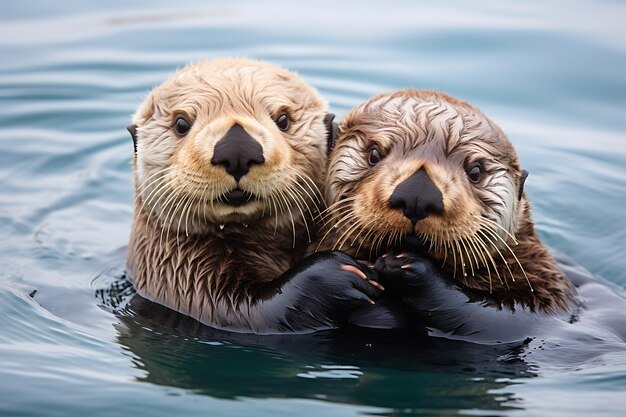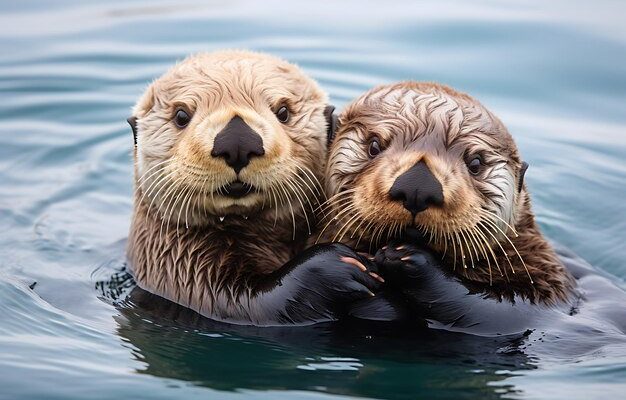
From their playful behavior to their aquatic habitats, these animals have various connections to sea otters. In this article, we’re going to explore ten animals that are similar to sea otters and how to tell them apart. So grab your coffee, sit back, and let’s dive into this fascinating world of furry friends!
1. River Otters
Let’s start with the closest relative of the sea otter—the river otter. These playful critters are often seen frolicking in freshwater streams and rivers. They have a similar sleek body shape as sea otters, which aids in their swimming. River otters are typically smaller, weighing between 50 to 100 pounds, while sea otters can weigh up to 100 pounds or more.
You might notice that river otters have longer, narrower faces and their fur tends to be a rich brown or gray. They’re often more social than sea otters, living in groups called rafts that can include up to 20 individuals. Unlike sea otters that spend most of their time in the ocean, river otters are usually found in freshwater habitats.
How to Tell Them Apart
To spot the differences, look for their habitats. If you see an otter splashing in a lake or along a river, it’s likely a river otter. Additionally, if you observe them playing in groups, that’s a clear indicator. Remember, sea otters are more solitary floaters, enjoying their time in ocean waters.
2. Beavers
Next up is the beaver, another aquatic mammal but with a very different lifestyle. Beavers are nature’s engineers, building dams and lodges that can alter entire ecosystems. They have broad, flat tails and strong front teeth designed for gnawing on wood. While beavers primarily live in freshwater, they’re also semi-aquatic, much like otters.
Beavers are generally heavier than river otters, weighing between 35 to 110 pounds. Their fur is thick, providing insulation in cold waters, but they don’t have the same luxurious coat as sea otters. Beavers are usually more solitary, only coming together during mating season.
How to Tell Them Apart
The easiest way to differentiate between beavers and sea otters is by their tails. Beavers have large, flat tails perfect for swimming and balance, while sea otters have round, furry tails. Additionally, if you see a pile of sticks or logs, you may be close to a beaver’s home.
3. Lontra (Giant Otter)
The giant otter, or Lontra, is a unique species found in the rivers of South America. They resemble their smaller cousins, the river otters, but can grow up to six feet long! Giant otters have a lighter fur color, often a creamy brown, and unlike sea otters, they thrive in freshwater environments.
These magnificent creatures are also known for their vocalizations, often communicating with a series of chirps and whistles. They usually hunt in pairs or family groups, showcasing a social lifestyle similar to river otters.
How to Tell Them Apart
If you’re trying to identify a giant otter, look for their impressive size and lighter fur. Unlike the solitary sea otter, giant otters are social and tend to live in smaller family units, making them easier to spot in pairs or groups.
4. European Otters
The European otter is another species worth mentioning. Found across Europe, these otters prefer freshwater habitats like rivers and lakes. They’re slightly smaller than sea otters and have a long, thin body that makes them excellent swimmers.
European otters have distinctive markings, often sporting a lighter throat and underbelly. They’re known to be more elusive, often hiding in dense vegetation along riverbanks, which makes spotting them a bit of a challenge.
How to Tell Them Apart
To distinguish a European otter, pay attention to its habitat. If you’re in Europe and see an otter in freshwater rather than the ocean, there’s a good chance it’s a European otter. Plus, their slender shape and markings set them apart from the bulkier sea otter.
5. Sea Lions
While not an otter, sea lions share the same marine habitat and can resemble sea otters at a distance. These pinnipeds are larger and can weigh anywhere from 200 to 800 pounds. They have external ear flaps and long front flippers, which allow them to move swiftly on land as well.
Sea lions are known for their playful behavior and vocalizations, often barking loudly to communicate with one another. You can usually find them lounging on rocks or beaches in sunny areas, basking in the warmth.
How to Tell Them Apart
If you spot an animal on a beach that’s barking and sunbathing, it’s likely a sea lion. In contrast, sea otters are smaller, spend their time floating in the water, and don’t have the characteristic ear flaps.
6. Walruses
Another marine alternative is the walrus. Known for their long tusks and massive size, walruses are truly unique in the animal kingdom. While they share a habitat with sea otters, they can weigh over a ton! Their skin is wrinkled and thick, and they often gather in large groups on icy shores.
Walruses are also known for their whiskers, which they use to sense their environment. They feed primarily on mollusks, diving deep into the ocean for food.
How to Tell Them Apart
The size difference is the major indicator here. If you see a creature with tusks lounging on an ice floe, it’s definitely a walrus. Sea otters, with their small, rounded bodies and lack of tusks, are hard to confuse with these giants.
7. Penguins
Penguins, while flightless birds, also share aquatic traits similar to sea otters. They’re excellent swimmers and can dive deep for fish. Found mostly in the Southern Hemisphere, they have a distinct black-and-white coloring that makes them easily recognizable.
Unlike sea otters, penguins don’t have fur; they have feathers that are waterproof. Though they spend a lot of time in the water fishing, they also come to land to breed and raise their young.
How to Tell Them Apart
If you see an animal swimming with flippers in icy waters and it’s black and white, it’s probably a penguin. Unlike sea otters, you won’t find them floating on their backs; they’re more likely to be diving for food.
8. Dugongs
Dugongs are marine mammals that can often be confused for a large sea otter from a distance due to their similar aquatic lifestyle. They’re sometimes called “sea cows” and are herbivores, primarily feeding on seagrass. Dugongs are much larger than sea otters, typically weighing around 600 to 1,100 pounds.
They have a unique, streamlined body and a paddle-like tail, which helps them swim gracefully through the water. While they are not directly related to otters, they share the same marine environments.
How to Tell Them Apart
Dugongs are much larger and have a more elongated body compared to the round shape of sea otters. If you see a large, gentle creature grazing in shallow waters, it’s likely a dugong rather than an otter.
9. Manatees
Manatees, like dugongs, are large aquatic mammals known for their gentle nature. They also eat seagrass, making them herbivorous. These slow-moving creatures can weigh between 440 to 1,200 pounds, making them significantly heavier than sea otters.
Manatees have a rounded body and a flat, paddle-shaped tail, which helps them glide through the water. They’re often found in warm coastal areas.
How to Tell Them Apart
If you see a large, slow-moving creature near the surface of warm waters munching on vegetation, it’s a manatee. They don’t have the playful, buoyant behavior of sea otters, who tend to float on their backs.
10. Polar Bears
Finally, we have the polar bear, a majestic creature of the Arctic. Though not aquatic in the same way as sea otters, they do rely on sea ice to hunt seals and can swim for long distances. Polar bears are much larger than any otter, weighing between 900 to 1,600 pounds.
Their white fur provides excellent camouflage in snowy environments, and they have powerful limbs for swimming. While similar in habitat, their hunting behavior and size are vastly different from sea otters.
How to Tell Them Apart
Polar bears are recognizable by their large size and white fur. Unlike sea otters, they’re not known for floating and playing in the water; instead, they’ll be found hunting on the ice.
As we wrap up, it’s clear that while sea otters are unique and lovable creatures, they share the world with a variety of animals that share similar traits or habitats. From river otters to giant otters, each has its own charm and important role in the ecosystem. The next time you’re near the water, take a moment to appreciate not only the sea otters but also their remarkable relatives. By understanding these creatures, we can better appreciate the diversity and beauty of our natural world.

